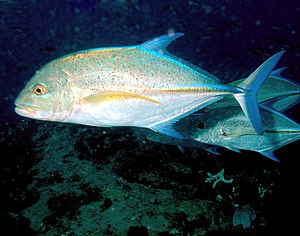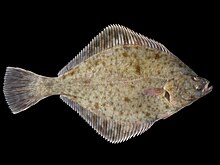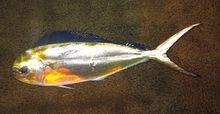Carangiformes
| Carangiformes | ||||||||||||
|---|---|---|---|---|---|---|---|---|---|---|---|---|

Bluefin mackerel ( Caranx melampygus ) |
||||||||||||
| Systematics | ||||||||||||
|
||||||||||||
| Scientific name | ||||||||||||
| Carangaria | ||||||||||||
| Betancur-R . et al., 2013 | ||||||||||||
| Scientific name of the order | ||||||||||||
| Carangiformes | ||||||||||||
| Jordan , 1923 |
The Carangiformes are a bony fish order from the group of perch relatives (Percomorpha). In total, almost 1000 fish species belong to the Carangiformes, with flatfish making up the vast majority of species with over 770 species. Almost all species of the Carangiformes live in the sea, a few also in brackish water and in fresh water . All Carangiformes feed on carnivore, some are among the top predators of their habitats ( swordfish relatives , barracudas , giant perches ).
features
The relationship of these outwardly very different families of the Carangiformes is based exclusively on the comparison of DNA sequences and has not yet been supported by morphological autapomorphies , which would differentiate the group from other perch relatives. Little, Lougheed, and Moyes mentioned a relatively low number of vertebrae, some fin-carriers in front of the second spinous process, and the absence of supraneuralia (parts of the vertebrae) as potential anatomical synapomorphies of a common clade of flatfish, swordfish relatives, and jacks. However, some of these characteristics are missing from the other groups of the Carangiformes and others are original characteristics ( plesiomorphies ), which arose before the trunk line of the Carangiformes and cannot establish monophyly .
Systematics
The Carangiformes received their current composition in a comprehensive revision of the regulations published in May 2020 . Before the flatfish were an independent order, in other families the assignment to an order was uncertain. The revision was taken over by the monthly updated systematic fish database "Eschmeyer's Catalog of Fishes" at the beginning of June 2020. In this composition, the Carangiformes correspond to the Carangimorpha, which were proposed by Li and colleagues in 2009 , and the Carangaria, which are one of nine clades in those of the fish systematist Ricardo Betancur-R. and his colleagues subdivide the perch relatives (Percomorpha), and the The Carangaria are the sister group of the Anabantaria to which the order of the gill-slit hall-like (Synbranchiformes) and the order of the climbing fish-like (Anabantiformes) belong.




The internal systematics of the Carangiformes according to Girard and co-workers (2020):
-
Carangiformes
- Subordination Centropomoidei
- Giant Bass (Latidae)
- Snooks (Centropomidae)
- Lactariidae
- Barracudas (Sphyraenidae)
- Suborder Polynemoidei
- Threadloss (Polynemidae)
- Partial order flatfish (Pleuronectoideo)
- Psettodidae
- Citharidae (Citharidae)
- Turbot (Scophthalmidae)
- Butte (Bothidae)
- Cyclopsettidae
- Sham butt (Paralichthyidae)
- Plaice (Pleuronectidae)
- American sole (Achiridae)
- Paralichthodidae
- South Pacific flounder (Rhombosoleidae)
- Southern flounder (Achiropsettidae)
- Oncopteridae
- Comb flounder (Samaridae)
- Poecilopsettidae
- Sole (Soleidae)
- Dog tongues (Cynoglossidae)
- Suborder Toxotoidei
- Leptobramidae
- Archer fish (Toxotidae)
- Subordination Nematistioidei
- Subordination menoidei
- Subordinate mackerel relatives (Carangoidei)
- Jackfish (Carangidae)
- Superfamily Echeneoidea
- Ship keeper (Echeneidae)
- Cobia (Rachycentridae)
- Golden mackerel (Coryphaenidae)
- Subordination Centropomoidei
| Carangiformes cladogram | |||||||||||||||||||||||||||||||||||||||||||||||||||||||||||||||||||||||||||||||||||||||||||||||||||||||||||||||
|---|---|---|---|---|---|---|---|---|---|---|---|---|---|---|---|---|---|---|---|---|---|---|---|---|---|---|---|---|---|---|---|---|---|---|---|---|---|---|---|---|---|---|---|---|---|---|---|---|---|---|---|---|---|---|---|---|---|---|---|---|---|---|---|---|---|---|---|---|---|---|---|---|---|---|---|---|---|---|---|---|---|---|---|---|---|---|---|---|---|---|---|---|---|---|---|---|---|---|---|---|---|---|---|---|---|---|---|---|---|---|---|
|
supporting documents
- ↑ a b c d Matthew G. Girard, Matthew P. Davis, W. Leo Smith: The Phylogeny of Carangiform Fishes: Morphological and Genomic Investigations of a New Fish Clade. Copeia, 108 (2): 265-298 (2020). doi: 10.1643 / CI-19-320
- ↑ Alexander Little, Stephen C. Lougheed, Christopher D. Moyes: Evolutionary affinity of billfishes (Xiphiidae and Istiophoridae) and flatfishes (Plueronectiformes): independent and trans-subordinal origins of endothermy in teleost fishes. Molecular Phylogenetics and Evolution 56 (3): 897-904 April 2010 DOI: 10.1016 / j.ympev.2010.04.022
- ↑ a b Ricardo Betancur-R, Edward O. Wiley, Gloria Arratia, Arturo Acero, Nicolas Bailly, Masaki Miya, Guillaume Lecointre and Guillermo Ortí: Phylogenetic classification of bony fishes . BMC Evolutionary Biology, BMC series - July 2017, DOI: 10.1186 / s12862-017-0958-3 . Page 24.
- ↑ Eschmeyer's Catalog of Fishes: Species by Family / Subfamily
- ↑ Blaise Li, Agnès Dettaï, Corinne Cruaud, Arnaud Couloux, Martine Desoutter-Meniger, Guillaume Lecointre: RNF213, a new nuclear marker for acanthomorph phylogeny. Molecular Phylogenetics and Evolution 50 (2009): 345-363 doi : 10.1016 / j.ympev.2008.11.013
